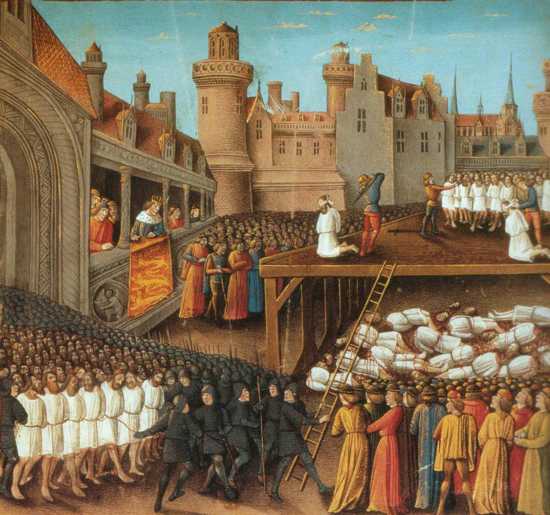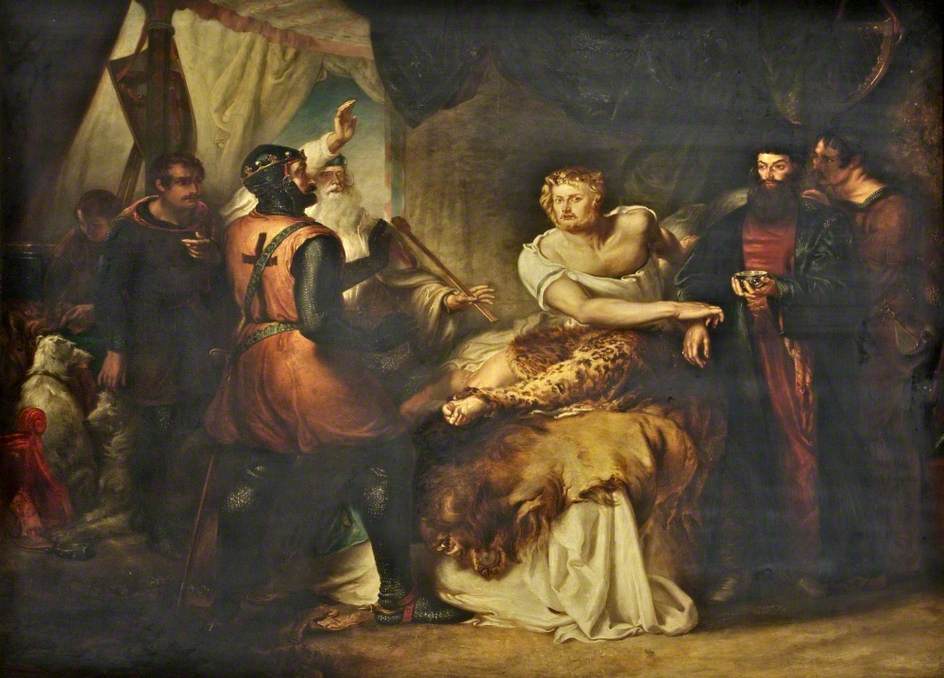The immediate cause of the Third Crusade was the fall of Jerusalem in 1187. Not surprisingly brutality was familiar to both Muslims and Christians during the fighting. There is no record of Saladin ever using his sword, except of course to kill unarmed prisoners after victory. In every respect he was the pattern of the Muslim ruler: he said his prayers regularly and kept the fast of Ramadan. He loved to listen to readings from the holy books, even when he rode down the front of a hostile army. his almsgiving was said to be so generous that when he died only one gold dinar remained in his treasury. His mercy was famous, but it was a Muslim mercy, not to be judged by Christian standards.

—They numbered more than three thousand and were all bound with ropes. The Franks then flung themselves upon them all at once and massacred them with sword and lance in cold blood. Our advanced guard had already told the Sultan of the enemy’s movements and he sent it some reinforcements, but only after the massacre. The Musulmans, seeing what was being done to the prisoners, rushed against the Franks and in the combat, which lasted till nightfall, several were slain and wounded on either side. On the morrow morning our people gathered at the spot and found the Musulmans stretched out upon the ground as martyrs for the faith. They even recognised some of the dead, and the sight was a great affliction to them. The enemy had only spared the prisoners of note and such as were strong enough to work.—click image for source…
…Brutality was familiar to both Moselems and Christians during the fighting. Saladin’s sense of honour did nor prevent him from severing the head of Reynald of Chatillon with a stroke of his sword after that undisciplined Lord had raided a rich Arab desert caravan. Such cruelty was outdone by Richard, who calmly watched the slaughter of 2,700 Muslim survivors in Acre after the city had been won by the Christians in the summer of 1191. The image above shows the decapitated prisoners in their white robes stacked beneath the wooden gallows.

The legends that grew out of the Third Crusade never failed to recount the mutual respect that Richard and Saladin had for each other. The above painting by Solomon Alexander Hart illustrates the scene described by Sir Walter Scott in The Talisman of the purely imaginary visit paid by Saladin to the bedside of Richard during his prolonged illness. Disguised as an Arab physician, Saladin is about to give medication to the fever-ridden English monarch. click image for source…
ADDENDUM:
(see link at end)…Key to the campaign’s success was the capture of the port city of Acre. King Richard arrived on the scene in June 1191 to find the city under siege by a Christian army. In the distance, Saladin threatened – his army too weak to overwhelm the besiegers, but too strong to be dislodged.
Intensifying the bombardment of the city, Richard and the French King, Phillip, slowly broke the city’s walls, weakening its defenses while simultaneously starving the occupiers into submission. Finally, on July 12, the Muslim defenders and Crusaders agreed to surrender terms. In exchange for sparing the lives of the defenders, Saladin would pay a ransom of 200,000 gold pieces, release some 1500 Christian prisoners and return the Holy Cross. These actions were to be accomplished within one month after the fall of the city. Richard would hold 2,700 Muslim prisoners as hostage until the terms were met.
Saladin immediately ran into problems meeting his part of the bargain and the deadline came without payment of the terms. As a compromise, Saladin proposed that Richard release his prisoners in return for part of the ransom with the remainder to be paid at a later date. Saladin would provide hostages to Richard to assure payment. Alternatively, he proposed to give Richard what money he had and allow Richard to keep the prisoners in return for Christian hostages to be held until the remainder of the money was raised and the Muslim prisoners released. Richard countered that he would accept the partial payment but Saladin must accept his royal promise to release his prisoners when he received the remainder of the ransom. Neither ruler would accept his opponent’s terms. Richard declared the lives of the Muslim defenders of Acre forfeit and set August 20 as the date for their exec
n.Read More:http://www.eyewitnesstohistory.com/lionheart.htm





 COMMENTS
COMMENTS